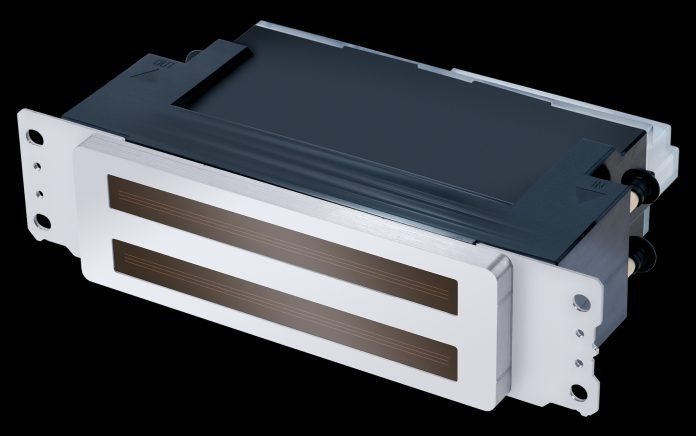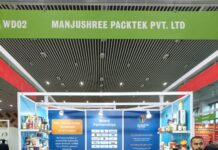
Seiko launched its new 600 dpi inkjet printhead at drupa for water-based inks at the People and Technology stand at drupa24. The long-awaited printhead is the upgraded version of the company’s existing 360 dpi RC1536 but with a higher nozzle density, making possible faster speeds for water-based inks that will allow Seiko to target new markets including packaging and textiles.
Ali Eranpurwala, head of inkjet printhead sales at Seiko Instruments Europe, explains the new Seiko printhead, “We have taken the RC1536 printhead that we already have with full nozzle level recirculation, and we have reduced the size of the channels to pack in more nozzles to get 600 dpi. So each row, instead of having 90 dpi now, has 150 dpi in the RCE2560. In total, there are four nozzle rows, which combine to form 600 dpi.”
The RCE2560 has a print width of 108.3 mm with 2560 nozzles. The head can generate drop sizes from 9 to 30 picolitres with a jetting frequency of 40kHz. This should lead to a very competitive print speed of 100 meters per minute at 600 dpi. It has a jetting velocity of 7 mps at a throw distance of 3 mm. It can print both horizontally and vertically. In addition, where the RC1536 only supported a single channel, the new head has two channels meaning that two colors can be jetted at 300 dpi each.
The other big change is that Seiko has upgraded the electronics within the printhead, which has allowed it to introduce a new Isolated channel mode. Seiko started its printhead business through licensing Xaar’s shared wall shear mode technology, as did Konica Minolta and Toshiba Tec. The shared wall means that there is a single wall between adjacent ink chambers. Electrodes on either side of these walls allowed the walls to be flexed in either direction to force the ink out of the ink chamber and through the nozzle in a sheared mode. Previously, Seiko relied on the waveform to apply a positive charge to the electrodes to push the walls in one direction.
For those inks that do not conduct currents, such as oil-based or UV inks, it was possible to trigger the electrodes on the inside wall as well as the outer wall, which allowed the walls to be flexed in both directions. However, as Eranpurwala explains, “With water-based inks, we could not apply any current on the inner electrodes because they would be conducting, only on the outer electrode.” This meant that the shared walls between the ink chambers could only be flexed in one direction, which limited the performance with aqueous inks.
Eranpurwala continues, “But the new electronics allow us to use new waveforms, still just on the outer side but we can do this in both a positive and negative way, flexing that wall in both directions.” The net result is that this head is much better suited to water-based inks than previous Seiko printheads. “This allows us to obtain high directional accuracy because we can transfer more energy to the drops, as we can go outwards and inwards with our piezos.”
Eranpurwala explains some of the challenges of water-based inks, “We come from the ceramics market where we get a lot of pressure from the industry to print from a further distance, and to do that we need to transfer a lot of energy to the drops so that means that the movement of the piezo in both directions is necessary. When we moved to the water-based inks, we lost that squeeze motion because we could not trigger the electrodes on the inside of the channels. Now we are regaining this capability by using the positive and negative pulse on the electrodes that are not in the channel of ink.”
OEMs are free to design their waveforms but Eranpurwala notes, “It is open but we tell them that it is not an easy thing to do so if they allow us to do it then it is better. We don’t put a lock on it so people can change it if they want to but we can’t warranty the printhead after that as it’s difficult for us to know what they have done with the waveform. He adds, “Some of the ink manufacturers prefer to make their own waveform and they keep it to their ink so we do that with them.”
He says that Seiko has some experience in letting customers work their waveform having already opened it up for the RC1536 head, noting, “The RC1536 is much easier for waveform because there is no negative, we have only the positive movements but now that we have the positive and negative we, ourselves, don’t know how difficult it will be. So we don’t know how feasible it will be for anyone to change the waveform.”

Otherwise, the fundamental design remains the same, including the piezo and the electrode deposition process. Besides water-based inks, the RCE2560 will also jet UV-curable, oil, and solvent-based inks. In addition, it will handle a wide range of fluid viscosity, from 5 to 20cP, and possibly beyond this. Ryoichiro Yamashita, technical support manager for Seiko Instruments Europe, says that Seiko does not have any experience above 20cP so for now the range is listed as 5-20cP.
There is no heating or temperature control on the head. Yamashita says that its not needed, noting, “It’s difficult to handle heating the ink only on the printhead because we have a very high flow rate so it is better to control the temperature by the ink system.”
Eranpurwala says, “We have a good relationship with customers which is based on the technical support that we give them. Having that strong presence of technical staff here in Europe, and the nozzle level recirculation, the 600dpi and the through-flow technology with this high viscosity range, all these things are quantifiable benefits but I think the core benefit is still the way we do business, which people now expect from us.”
Seiko has also worked with both Meteor Inkjet and the small German company Aewa who have both developed drive electronics to support the RCE2560.
Initially, Seiko will focus on the corrugated market, though Ali Eranpurwala adds, “But textiles is also something that we are looking at.” He explains, “We are now approaching clients from all different markets, like packaging, and we have glass printing, even 3D printing and some people are asking us for direct-to-shape. So now we have to choose a few and start working with them because we can’t support everyone at the same time.”
The first samples of the new head should be available later this summer, around August, and Seiko will select some beta customers then. Eranpurwala adds, “We expect to go into full production by the end of this year.”
IndiFoodBev — authentic, impactful and influential
An English-language food and beverage processing and packaging industry B2B platform in print and web, IndiFoodBev is in its third year of publication. It is said that the Indian food and beverage industries represent approximately US$ 900 billion in revenues which implies more than 20% of the country’s GDP. Eliminating the wastage on the farmside can help to deliver more protein to a higher number of the population apart from generating sizable exports. The savings in soil, seeds, water, fertilizer, energy and ultimately food and nutrition could be the most immense contribution that country is poised to make to the moderation of climate change.
To improve your marketing and grow sales to the food and beverage processing and packaging industry, talk to us. Our research and consulting company IppStar [www.ippstar.org] can assess your potential and addressable markets in light of the competition. We can discuss marketing, communication, and sales strategies for market entry and growth.
Suppliers and service providers with a strategy and budget for targeted marketing can discuss using our hybrid print, web, video, and social media channels to create brand recognition linked to market relevance. Our technical writers are ready to meet you and your customers for content.
The second largest producer of fruit and vegetables in the world is continuously expanding processing capacities and delivery systems with appropriate innovative technologies. We cover product and consumer trends, nutrition, processing, research, equipment and packaging from farm to thali. Get our 2025 media kit and recalibrate your role in this dynamic market. Enhance your visibility and relevance to existing markets and turn potential customers into conversations. Ask for a sample copy of our bi-monthly in print or our weekly IndiFoodBev eZine each Wednesday.
For editorial info@ippgroup.in — for advertisement ads1@ippgroup.in and for subscriptions subscription@ippgroup.in
Naresh Khanna – 10 February 2025
Subscribe Now










